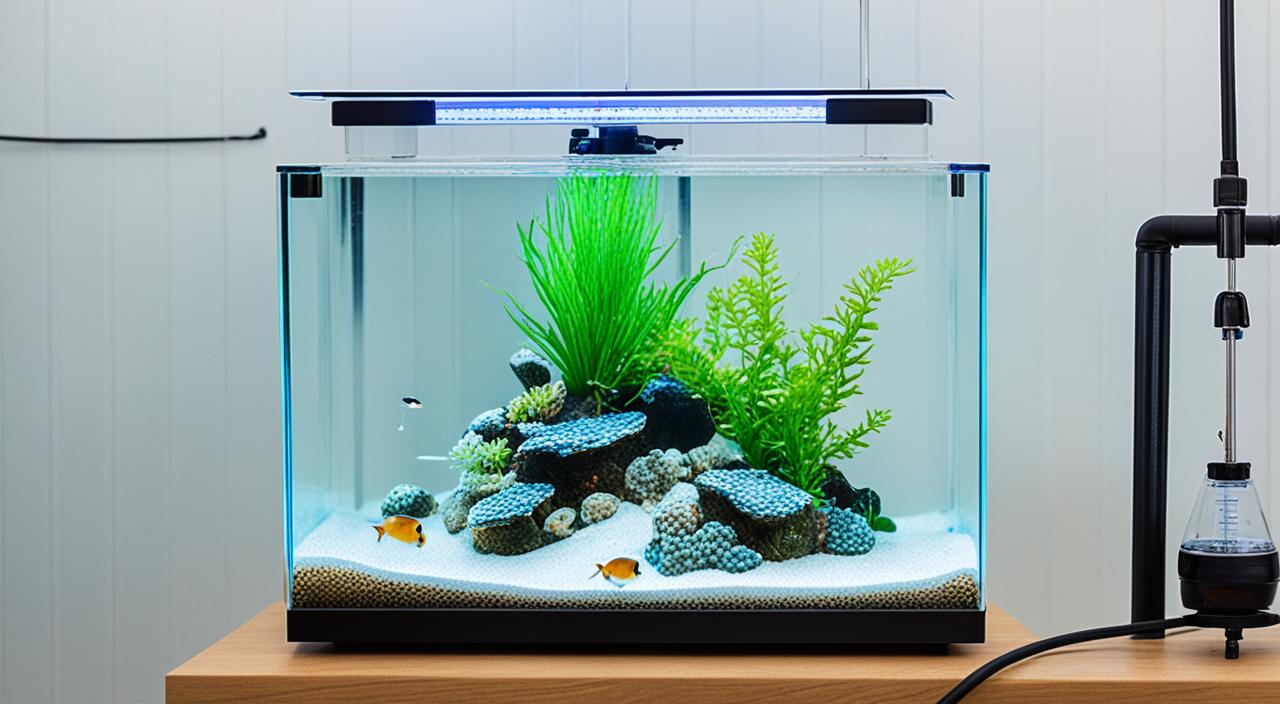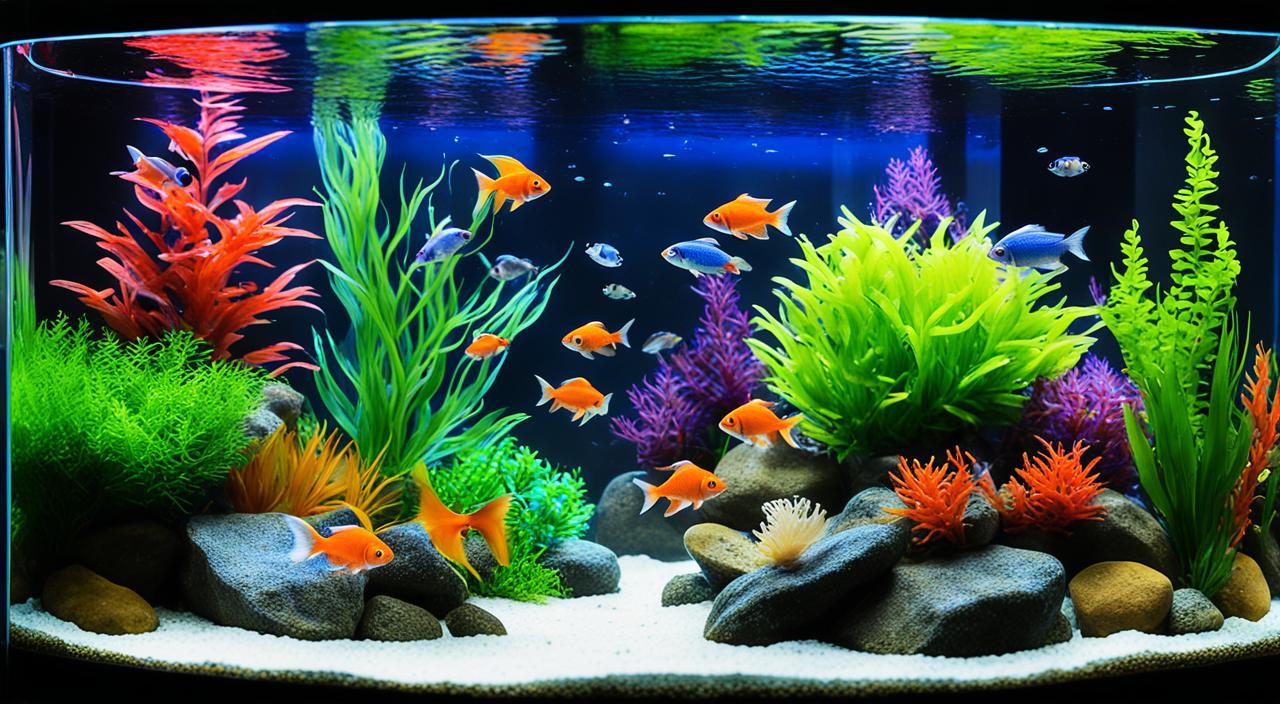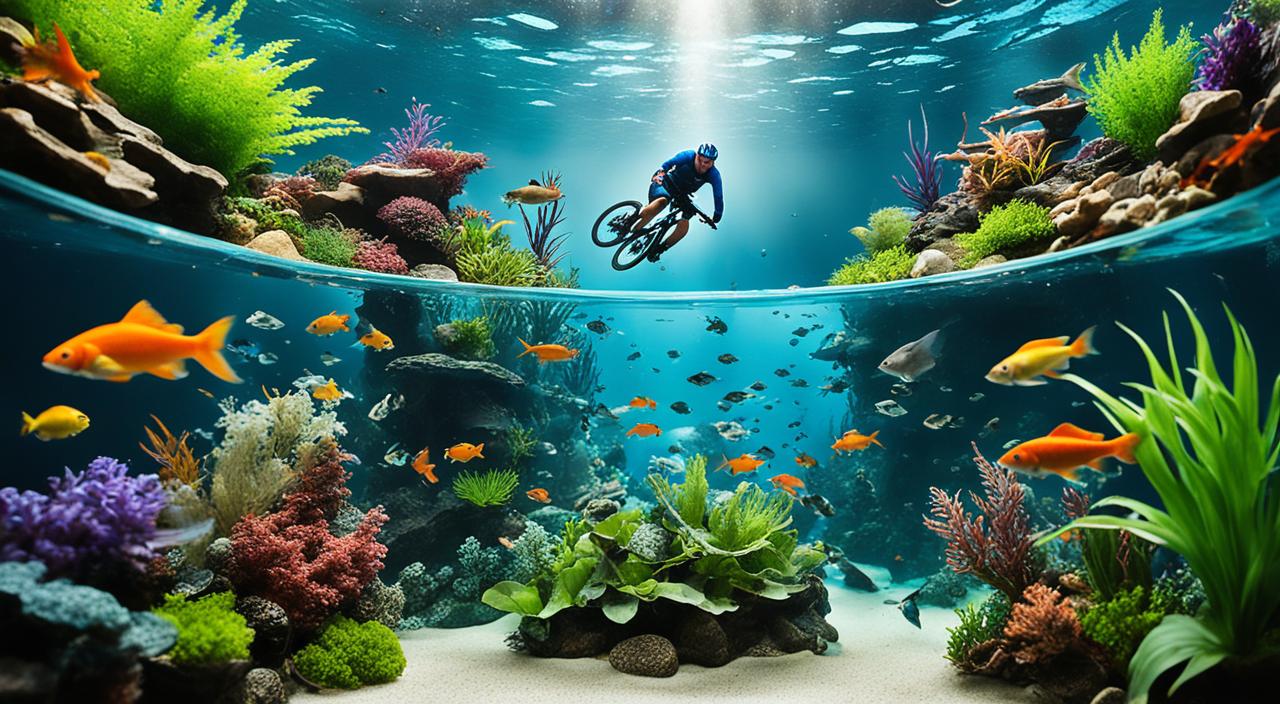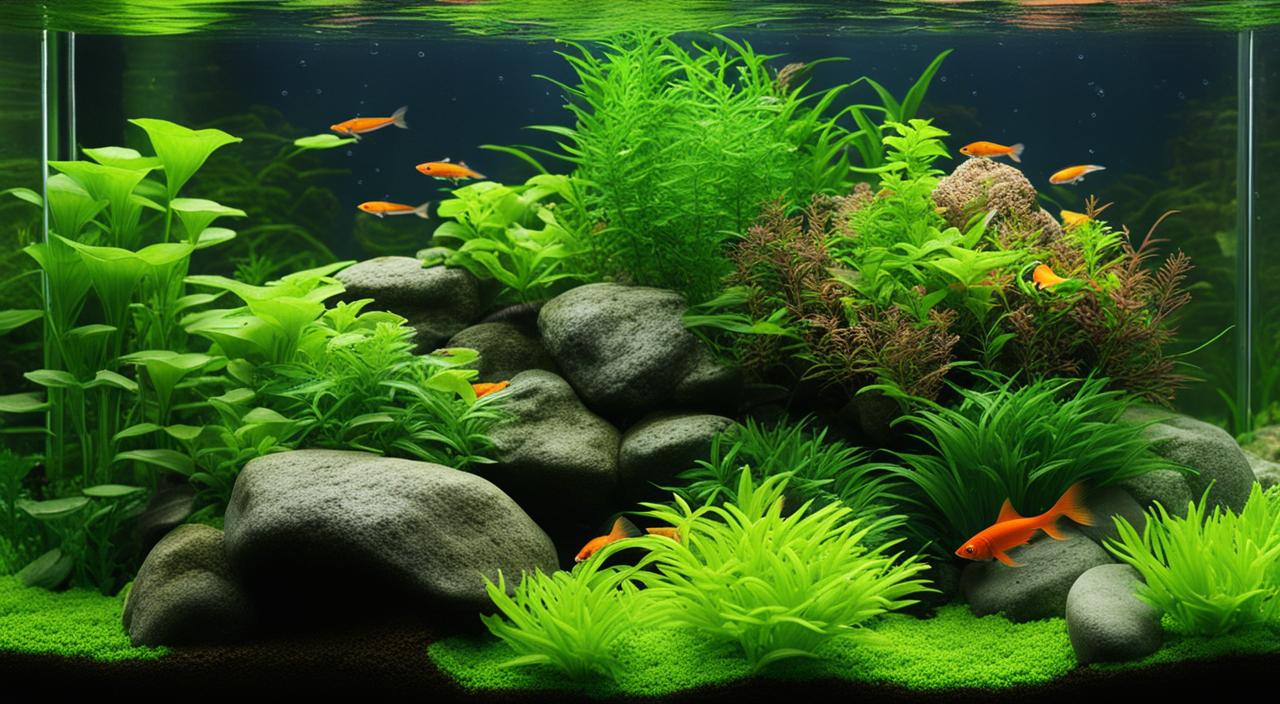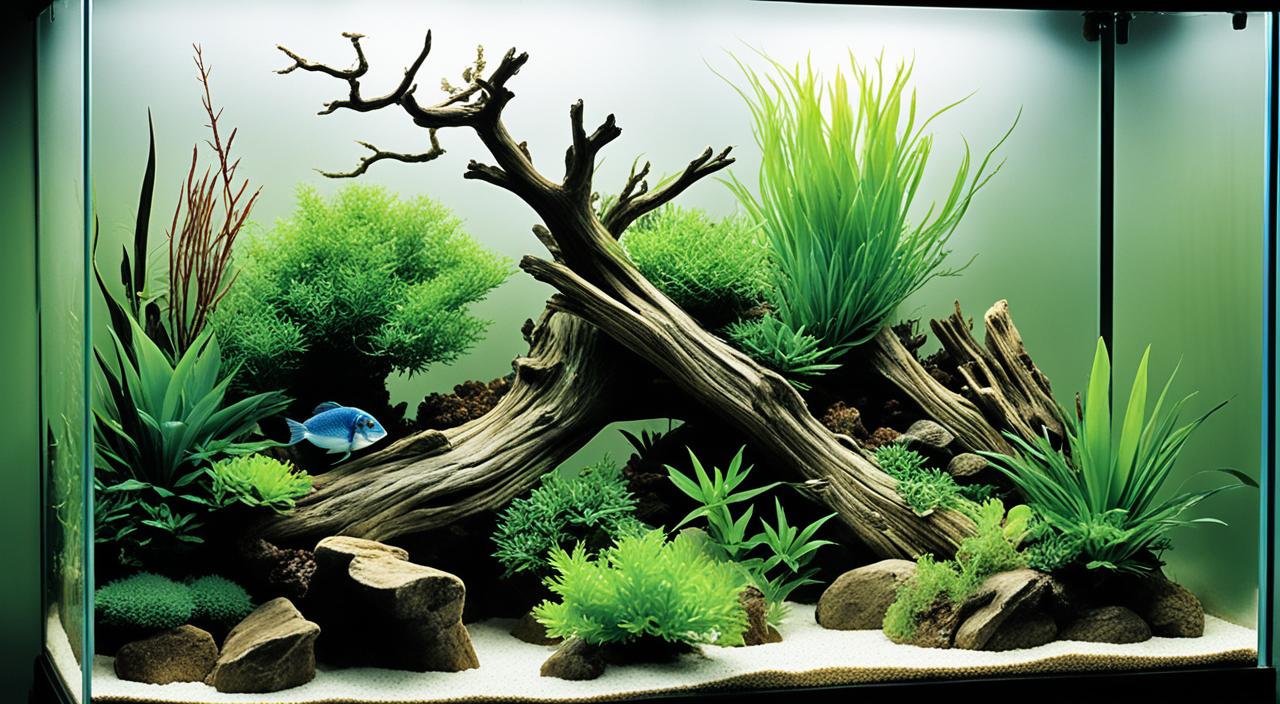Are you facing difficulties with the aquarium cycling process? Don’t worry; I’m here to help! In this comprehensive guide, I will walk you through the troubleshooting steps to ensure a successful cycling process for your aquarium. Whether you’re a beginner or an experienced aquarist, this guide will provide valuable insights and solutions to common problems. Let’s dive in!
Key Takeaways:
- Troubleshooting the aquarium cycling process is crucial for maintaining a healthy aquatic ecosystem.
- This comprehensive guide will provide you with step-by-step solutions to common cycling problems.
- Understanding the basics of aquarium cycling and the role of beneficial bacteria is essential for troubleshooting.
- Proper water parameter analysis and maintenance are key to sustaining a cycled aquarium long-term.
- Follow the troubleshooting techniques provided to overcome challenges and ensure a successful cycling process.
Understanding the Basics of Aquarium Cycling
To maintain a healthy aquarium ecosystem, it is crucial to understand the basics of aquarium cycling. This process is essential for the well-being of aquatic life and involves the aquarium nitrogen cycle, the conversion of harmful substances like ammonia to less toxic forms. You can ensure a thriving aquatic environment by grasping the importance of cycling and familiarizing yourself with standard terms such as ammonia, nitrites, and nitrates.
Defining the Aquarium Nitrogen Cycle
The aquarium nitrogen cycle is a natural biological process in every aquarium. It involves the transformation of waste products into less harmful substances through the action of beneficial bacteria. The cycle begins by introducing ammonia through fish waste or decomposing organic matter. This ammonia is then converted by nitrifying bacteria into nitrites, subsequently converted into nitrates. Nitrates are less toxic but should still be kept at acceptable levels through regular maintenance.
Importance of Cycling for Aquatic Life
Cycling is paramount for aquatic life as it establishes a stable and balanced environment within the aquarium. Ammonia and nitrites can accumulate to dangerous levels without proper cycling, causing stress and even death to fish and other aquatic inhabitants. By facilitating the growth of beneficial bacteria, cycling ensures the continuous breakdown of waste products, maintains water quality, and supports the overall health of the aquarium ecosystem.
Identifying Common Terms: Ammonia, Nitrites, and Nitrates
Ammonia, nitrites, and nitrates are standard terms when discussing aquarium cycling. Ammonia is a toxic compound excreted by fish and produced from decomposing organic matter in the tank. Nitrites are formed by converting ammonia during the cycling process and can also be harmful to aquatic life. Finally, nitrates are the least toxic form of nitrogenous waste and are typically removed through regular water changes. Monitoring and managing these substances is essential to ensure a safe and healthy aquarium environment.
Preparation Steps for Successful Cycling
Proper preparation is essential to ensure a successful aquarium cycling process. This section will guide you through the steps to set up your aquarium and choose the appropriate cycling method.
Setting Up Your Aquarium for the Cycling Process
Before starting the aquarium cycling process, setting up your aquarium correctly is important. Here are the key steps to follow:
- Choose the right size of the aquarium based on the type and number of fish you plan to keep. Ensure that the aquarium is properly cleaned and free from any residues or contaminants.
- Select the appropriate equipment, including a filter, heater, and lighting system, based on the specific needs of your fish species. Ensure that the equipment is functioning properly and meets the requirements of your aquarium size.
- Choose the right substrate for your aquarium. Gravel or sand can serve as a natural biological filter, promoting the growth of beneficial bacteria.
- Add decorations such as rocks, plants, and hiding spots to create a suitable and stimulating environment for your fish.
- Fill the aquarium with dechlorinated water, ensuring the water parameters such as temperature and pH are within the recommended range for the species you plan to keep.
- Allow the aquarium to cycle for a few days to stabilize the water chemistry and temperature before introducing any fish.
Choosing the Right Cycling Method: Fishless vs. Traditional
There are two main methods for aquarium cycling: fishless cycling and traditional cycling. The choice between these methods depends on personal preference and circumstances. Here’s a breakdown of each method:
- Fishless cycling: This method involves adding a source of ammonia to the aquarium, allowing it to be converted into nitrates by beneficial bacteria. It is a more controlled approach and eliminates the stress and potential harm to fish during the cycling process.
- Traditional cycling: In this method, fish are introduced into the aquarium during the cycling process. Their waste generates ammonia, which is then converted into nitrates by beneficial bacteria. While this method is less time-consuming, it can be harmful to the fish if not monitored carefully.
Consider the pros and cons of each method, as well as your experience level and commitment, when deciding which cycling method is best for you.
Identifying Common Cycling Problems
During the aquarium cycling process, aquarists may encounter several common problems that can hinder the progress of establishing a healthy ecosystem. This section will discuss these problems and provide a troubleshooting guide to help aquarists overcome them.
Recognizing Symptoms of New Tank Syndrome
New Tank Syndrome is a condition that can occur during the initial stages of the aquarium cycling process. It is characterized by high levels of ammonia and nitrite, leading to stress and potential harm to the aquatic life in the tank. Symptoms of New Tank Syndrome may include lethargic fish, gasping for air at the water surface, or fish struggling to maintain balance.
Detrimental Effects of Incorrect pH and Temperature
Incorrect pH and temperature levels can harm the aquarium cycling process. Fluctuations in pH can disrupt the activity of beneficial bacteria, while extreme pH levels can be toxic to the aquatic life in the tank. Likewise, temperature fluctuations outside the ideal range can slow the cycling process and stress the fish. Maintaining stable pH and temperature levels throughout the cycling process is crucial.
By recognizing the symptoms of New Tank Syndrome and understanding the detrimental effects of incorrect pH and temperature levels, aquarists can take proactive measures to troubleshoot these common cycling problems. The following section will provide detailed solutions and techniques to address these issues and ensure a successful aquarium cycling process.
The Role of Beneficial Bacteria in Cycling
In the fascinating aquarium cycling process, beneficial bacteria are crucial in creating a stable and healthy aquatic ecosystem. These nitrifying bacteria, which naturally occur in the aquarium, aid in converting harmful substances into less toxic forms, ensuring the well-being of your aquatic inhabitants.
Types of Nitrifying Bacteria and Their Functions
Two main types of nitrifying bacteria are involved in the cycling process: ammonia-oxidizing bacteria (AOB) and nitrite-oxidizing bacteria (NOB). These bacteria work together sequentially to convert toxic ammonia and nitrites into relatively harmless nitrates.
The AOB, commonly known as the nitrifiers, play a vital role in the initial cycling stage by oxidizing ammonia to nitrites. This conversion is essential as ammonia is highly toxic to aquatic life. Conversely, the NOB continues the process by oxidizing nitrites into nitrates, which are less harmful to aquatic organisms.
How to Cultivate Beneficial Bacteria During Cycling
To ensure the growth and establishment of beneficial bacteria during the cycling process, several factors must be considered:
- Provide a source of ammonia: Beneficial bacteria require ammonia to thrive. This can be achieved by using fish food, fish waste, or liquid ammonia as a source.
- Monitor water parameters: Regularly test and monitor ammonia, nitrite, and nitrate levels to gauge the progress of the cycling process. This allows you to adjust conditions if necessary.
- Establish a proper nitrogen cycle: The cycling process can take several weeks. Be patient and allow the beneficial bacteria to establish themselves. Avoid adding any aquatic inhabitants until the cycling process is complete.
- Avoid drastic changes: Sudden changes in temperature, pH levels, or water chemistry can disrupt the growth of beneficial bacteria. Maintain stable conditions to promote their development.
- Consider using a bacterial supplement: In some cases, you may use a bacterial supplement to accelerate the growth of beneficial bacteria. These supplements can help establish a healthy nitrogen cycle more quickly.
By cultivating and promoting the growth of beneficial bacteria, aquarists can create a stable and thriving environment for their aquatic pets. This vital process ensures the removal of harmful substances, maintaining the overall health of the aquarium ecosystem.
| Type of Bacteria | Function |
|---|---|
| Ammonia-Oxidizing Bacteria (AOB) | Oxidize ammonia to nitrites |
| Nitrite-Oxidizing Bacteria (NOB) | Oxidize nitrites to nitrates |
Cycling Process Troubleshooting
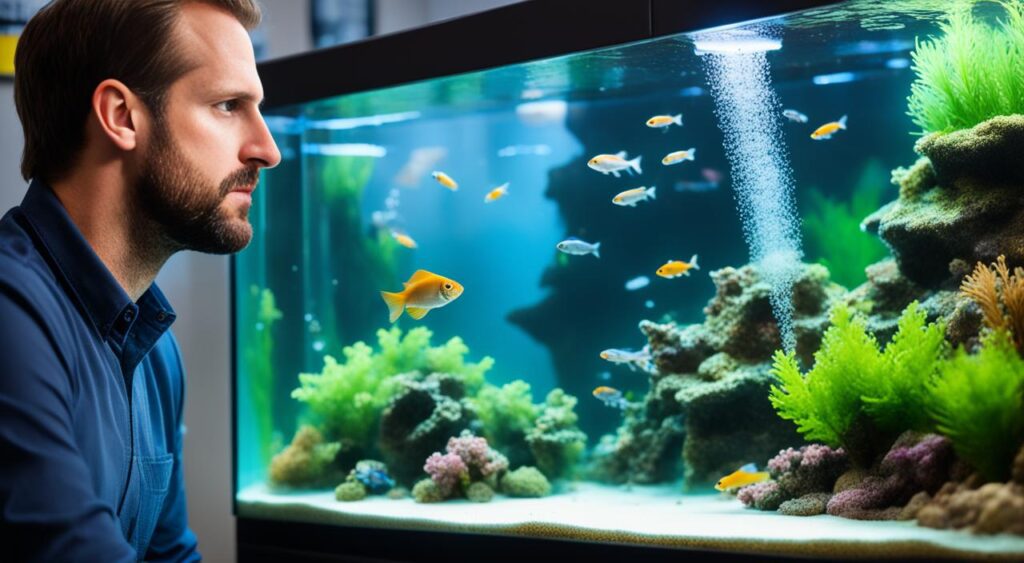
If your aquarium isn’t cycling correctly, it’s essential to identify and address the issues to ensure a successful cycling process. Several common problems can arise during the cycling process, including inadequate growth of beneficial bacteria and an imbalance in ammonia and nitrite levels. In this section, I will provide solutions and techniques to resolve these issues and overcome any challenges you may encounter.
Why Your Aquarium Isn’t Cycling Properly
If your aquarium is not cycling correctly, it could be due to several factors:
- Inadequate growth of beneficial bacteria: Beneficial bacteria play a vital role in cycling by converting harmful ammonia and nitrites into less toxic nitrates. If your aquarium lacks sufficient beneficial bacteria, ammonia and nitrite levels can remain elevated, preventing the completion of the cycling process.
- Imbalance in ammonia and nitrite levels: Ammonia and nitrite spikes can occur during the cycling process, posing a risk to the health of your aquatic life. High ammonia and nitrite levels can inhibit the growth of beneficial bacteria and impede the cycling process.
By understanding the underlying causes of improper cycling, you can take appropriate measures to resolve these issues and ensure a successful cycling process.
Resolving Ammonia and Nitrite Spikes
To address ammonia and nitrite spikes during the cycling process, consider the following steps:
- Partial water changes: Regular partial water changes can help reduce elevated ammonia and nitrite levels in your aquarium. Aim to replace approximately 25-50% of the water every 2-3 days to dilute the toxins and provide a healthier environment for your aquatic life.
- Testing and monitoring: Regularly test and monitor ammonia and nitrite levels using reliable test kits. This will allow you to track the progress of the cycling process and take necessary actions to mitigate any spikes.
- Adjusting feeding and cleaning routines: Overfeeding can increase ammonia levels in the aquarium. Ensure you are not overfeeding your fish and clean any excess food or debris to prevent an increase in ammonia and nitrite levels.
By implementing these measures, you can effectively resolve ammonia and nitrite spikes and create a safer environment for your aquatic life to thrive.
Dealing with Stalled Cycling: Solutions and Techniques
If your cycling process seems to be stalled, here are some solutions and techniques to consider:
- Boosting beneficial bacteria growth: To promote the growth of beneficial bacteria, you can add commercial bacterial supplement products specifically designed for aquariums. These supplements contain beneficial bacteria strains that can help establish and maintain a healthy bacterial colony.
- Increasing oxygen levels: Adequate oxygen levels are crucial for the growth of beneficial bacteria. Consider adding an air stone, increasing surface agitation, or using a higher flow rate on your filter to improve oxygenation in the aquarium.
- Patience and persistence: Cycling can take time, and patience is essential. Ensure you provide a consistent environment for the bacteria to multiply and establish a stable ecosystem.
By incorporating these solutions and techniques, you can overcome a stalled cycling process and successfully establish a healthy and balanced aquarium.
Analyzing Water Parameters for Cycling Maintenance
As part of maintaining a successful cycling process, it is crucial to regularly analyze the water parameters in your aquarium. This allows you to monitor the levels of ammonia, nitrite, and nitrate and ensure they are within the optimal range for a healthy aquatic environment.
How to Test and Interpret Ammonia, Nitrite, and Nitrate Levels
To test the ammonia, nitrite, and nitrate levels, you can use a water testing kit specifically designed for aquariums. These kits often include test tubes, reagents, and color charts to help you accurately measure and interpret the results.
When testing for ammonia, add a few drops of the provided reagent to a water sample in the test tube. Shake the tube gently and compare the color of the solution with the color chart to determine the ammonia level. Ammonia should ideally be at or near zero ppm for a cycled aquarium.
Similarly, to test for nitrites, follow the instructions provided with your testing kit. Nitrite levels should also be maintained at or near zero ppm for a properly cycled aquarium.
Nitrate levels, on the other hand, should be present in small quantities. Typically, it is recommended to keep nitrate levels below 20 ppm to prevent algae growth and ensure the overall health of your aquatic organisms.
Maintaining Optimal pH and Temperature During Cycling
In addition to testing ammonia, nitrite, and nitrate levels, it is essential to maintain optimal pH and temperature levels throughout the cycling process. Both pH and temperature can significantly impact the health and well-being of your aquarium inhabitants.
To monitor pH levels, you can use a pH testing kit to measure the acidity or alkalinity of the water. The ideal pH range for most freshwater aquariums is between 6.5 and 7.5, although certain fish species may have specific pH requirements. Monitor the pH regularly and make any necessary adjustments to keep it within the appropriate range.
Temperature is equally important, as different aquatic organisms have different temperature preferences. Use a reliable aquarium thermometer to monitor the water temperature consistently. Most tropical freshwater fish thrive within a temperature range of 72-82°F (22-28°C). Adjust the aquarium heater and monitor the temperature regularly to maintain a stable and suitable environment for your fish and other inhabitants.
Cycling Troubleshooting Techniques
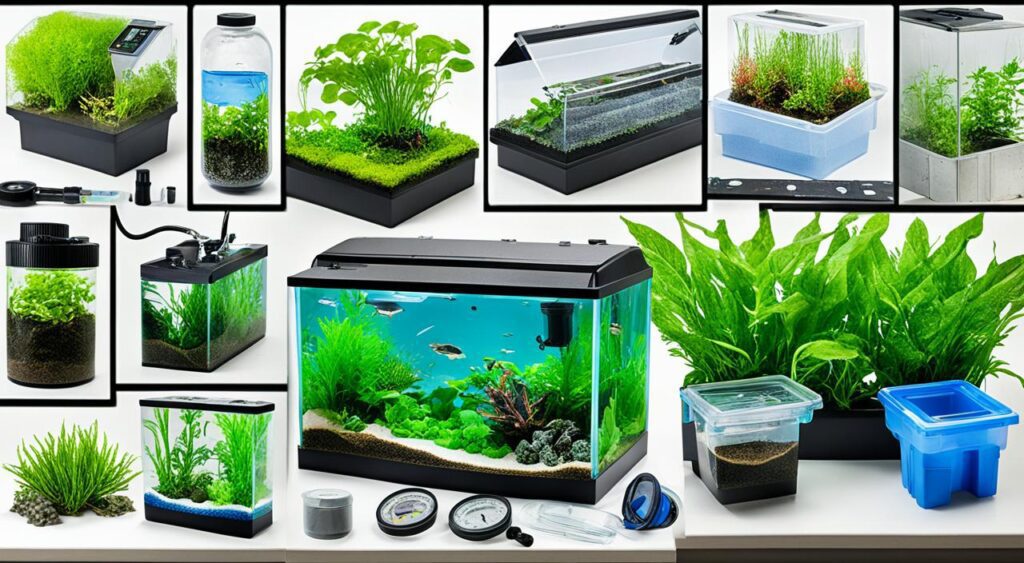
In the process of cycling your aquarium, you may encounter certain challenges that can hinder the progress. However, with the right troubleshooting techniques, you can overcome these obstacles and ensure a successful cycling outcome. Here are some tips to accelerate the cycling process and avoid common pitfalls:
Tips to Accelerate the Cycling Process
- Use a bacterial starter product: Adding a bacterial starter product containing beneficial nitrifying bacteria can help jumpstart the cycling process by introducing a healthy colony of bacteria into the aquarium.
- Increase water temperature: Raising the water temperature slightly can speed up the activity of beneficial bacteria, thus accelerating the cycling process. However, be cautious not to exceed the temperature range suitable for your fish.
- Limit feeding: During the cycling process, it’s important to minimize the amount of food you provide to avoid excessive ammonia production. Feeding sparingly will help prevent ammonia spikes and create a more stable environment for beneficial bacteria to establish.
- Add live plants: Live aquarium plants can contribute to the overall health of your tank by absorbing nitrates and adding oxygen to the water. They also provide a natural habitat for beneficial bacteria.
Common Pitfalls and How to Avoid Them
- Overstocking the tank: Avoid the temptation to add too many fish too quickly. Overstocking can lead to high ammonia and nitrite levels, which can be detrimental to the cycling process. Gradually introduce fish to the tank as the cycling progresses.
- Skipping water changes: Regular water changes are essential for maintaining optimal water parameters during the cycling process. Neglecting water changes can result in the accumulation of toxins and hinder the growth of beneficial bacteria. Stick to a consistent water change schedule.
- Using medications and chemicals: The use of certain medications and chemicals can disrupt the cycling process and harm beneficial bacteria. Whenever possible, opt for natural methods of maintaining water quality and addressing fish health issues.
- Impatience: Cycling an aquarium requires patience. Rushing the process can lead to imbalances and setbacks. Follow the steps and troubleshooting techniques patiently, and allow nature to take its course.
By implementing these troubleshooting techniques and following the tips provided, you can overcome obstacles, accelerate the cycling process, and create a thriving aquatic environment for your fish and plants.
Maintaining a Cycled Aquarium Long-Term
Regular monitoring and maintenance are crucial for sustaining the cycling performance of your aquarium. By consistently observing and addressing any fluctuations in cycling parameters, you can ensure a stable and healthy aquatic environment for your fish and other aquatic inhabitants. Here are some tips on how to maintain a cycled aquarium in the long term.
Regular Monitoring and Maintenance for Sustained Cycling Performance
To maintain a cycled aquarium, it is essential to monitor key parameters such as ammonia, nitrite, and nitrate levels regularly. By regularly testing these levels, you can identify any changes or fluctuations that may occur over time. It is recommended to perform water tests at least once a week, especially during the early stages of cycling and after any major changes or additions to your aquarium.
In addition to water parameter testing, regular maintenance tasks such as water changes and filter maintenance are vital for sustained cycling performance. Weekly partial water changes of around 10-20% help to remove any accumulated nitrates and maintain water quality. Cleaning and maintaining your filter by rinsing media and replacing filter pads as needed will ensure optimal filtration efficiency and prevent any buildup of debris or waste.
How to Respond to Fluctuations in Cycling Parameters
If during your regular monitoring you notice any fluctuations in cycling parameters, it is crucial to take appropriate action to maintain a stable environment for your aquatic life. For example, if ammonia or nitrite levels begin to rise, it may indicate an imbalance in the cycling process or a temporary disruption in the beneficial bacteria colony. In this case, performing a partial water change can help dilute the toxins and reduce their concentration.
It is also important to identify and address the underlying cause of parameter fluctuations. Factors such as overfeeding, overstocking, or inadequate filtration can contribute to cycling issues. Adjusting feeding habits, reducing the number of fish, or upgrading your filtration system can help address these problems and restore a healthy cycling process.
By regularly monitoring and maintaining your cycled aquarium, and promptly responding to any fluctuations in cycling parameters, you can ensure the long-term health and stability of your aquatic ecosystem. This dedication to ongoing care and maintenance will provide a thriving environment for your fish and create a beautiful and enjoyable aquarium for years to come.
FAQ
What is aquarium cycling?
Aquarium cycling is the process of establishing a healthy nitrogen cycle in a new aquarium. It involves the growth of beneficial bacteria that convert toxic ammonia into nitrites and then into less harmful nitrates. This cycling process is crucial for creating a stable and healthy aquatic environment.
How long does the aquarium cycling process take?
The duration of the aquarium cycling process can vary. It usually takes anywhere from 2 to 8 weeks for the beneficial bacteria to colonize the tank and complete the nitrogen cycle. Patience is key during this period to ensure a successful and stable cycling process.
What is New Tank Syndrome?
New Tank Syndrome refers to a condition that can occur during the initial stages of aquarium cycling. It is characterized by high ammonia and nitrite levels, which are harmful to fish and other aquatic creatures. Symptoms of New Tank Syndrome include fish stress, lethargy, and even death. Regular water testing and proper cycling techniques can help prevent this syndrome.
What should I do if my aquarium is not cycling properly?
If your aquarium is not cycling properly, there may be a few issues to address. First, ensure that the beneficial bacteria are present and actively growing. Check ammonia and nitrite levels regularly to identify any imbalances or spikes. You can also try adding a bacterial supplement or changing the cycling method to jumpstart the process. Consulting with an experienced aquarist or professional may also provide valuable troubleshooting guidance.
How often should I test my aquarium water during the cycling process?
It is recommended to test your aquarium water parameters at least twice a week during the cycling process. Regular testing of ammonia, nitrite, and nitrate levels will help you monitor the progress of the cycling and identify any issues that need to be addressed. This will ensure a safe and healthy environment for your aquatic inhabitants.
Can I add fish to the aquarium during the cycling process?
It is generally not advisable to add fish to the aquarium during the cycling process. High levels of ammonia and nitrites can be harmful to fish and may result in stress or even death. However, you can choose to do a fish-in cycling method with hardy fish species if you closely monitor water parameters and take necessary precautions to maintain a suitable environment for them.
How can I speed up the aquarium cycling process?
There are a few techniques that can help speed up the aquarium cycling process. First, you can consider using a bacterial supplement specifically designed to promote the growth of beneficial bacteria. Another option is to “seed” the tank with beneficial bacteria from an established aquarium or filter media. Providing a consistent temperature and pH level within the ideal range for nitrifying bacteria can also help accelerate the cycling process.
How do I maintain a stable cycling process in my aquarium long-term?
To maintain a stable cycling process in your aquarium long-term, it is important to regularly monitor water parameters such as ammonia, nitrites, and nitrates. Perform regular partial water changes to keep these levels in check and promote a healthy environment for your aquatic life. Additionally, avoid overstocking the tank and ensure proper filtration and maintenance of the aquarium equipment.

